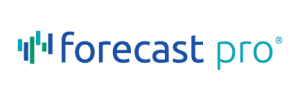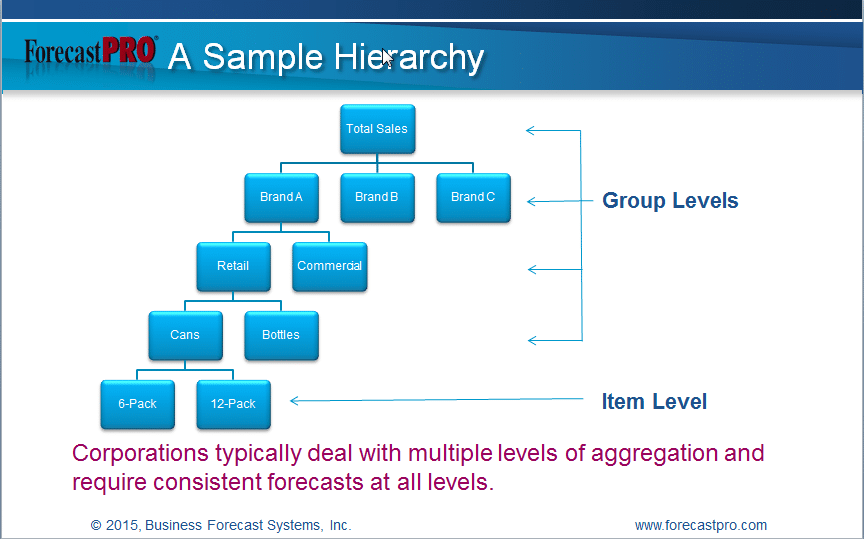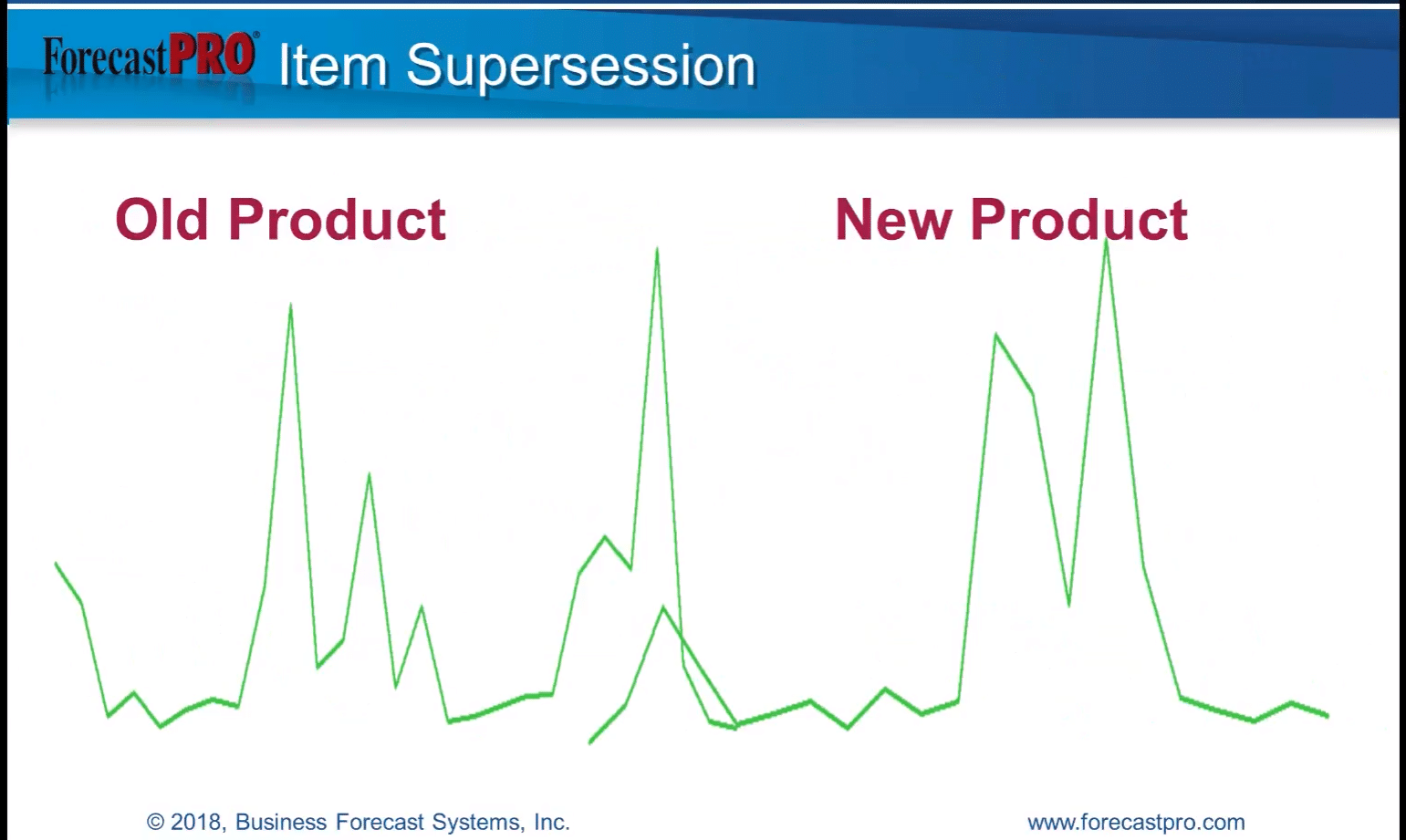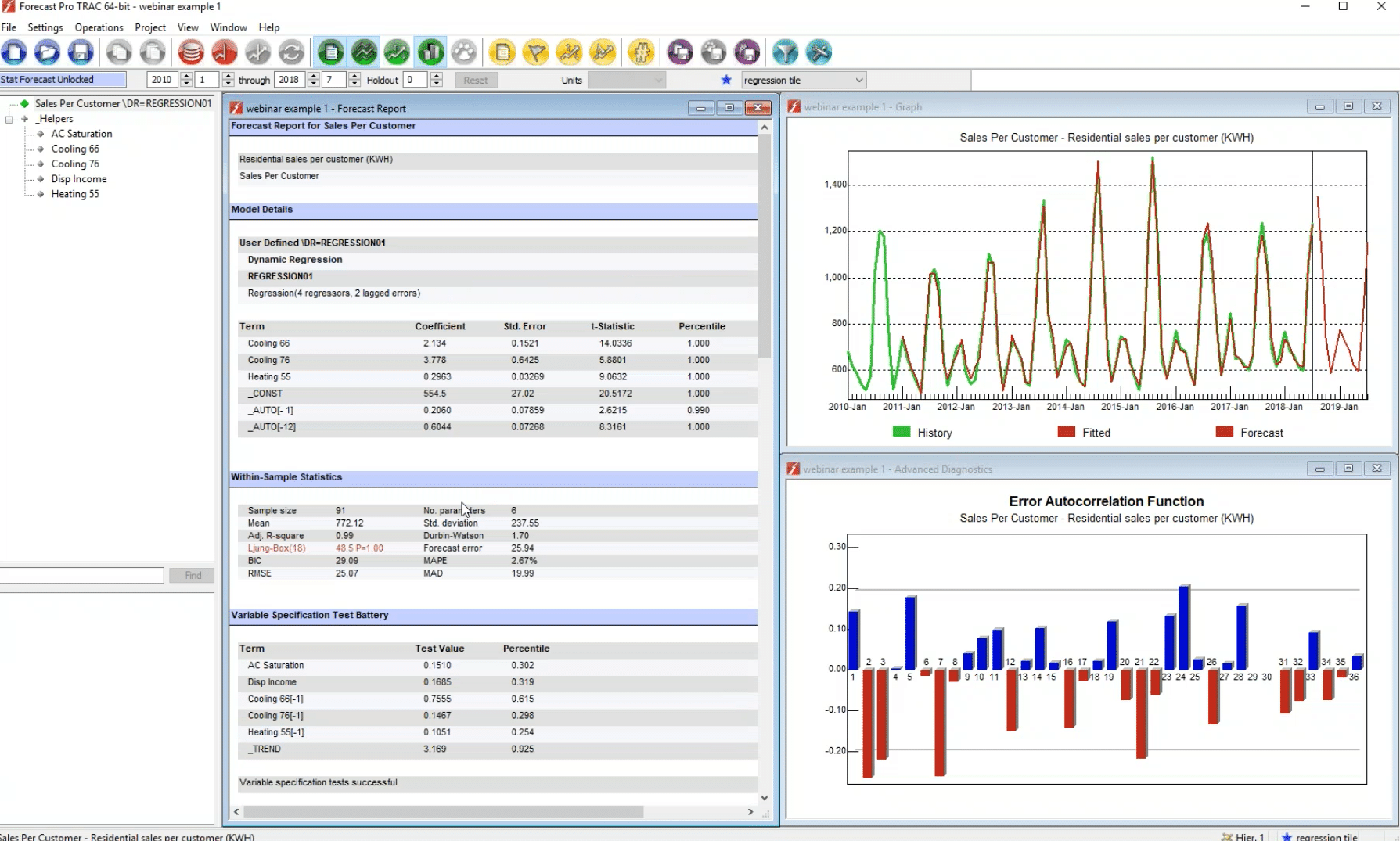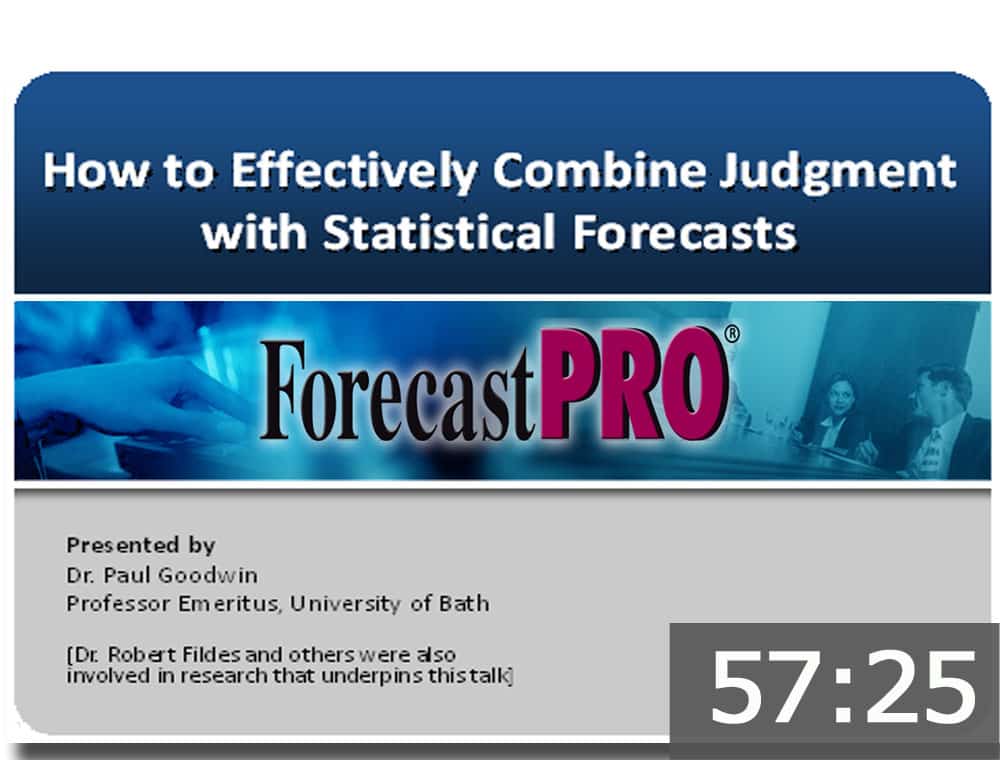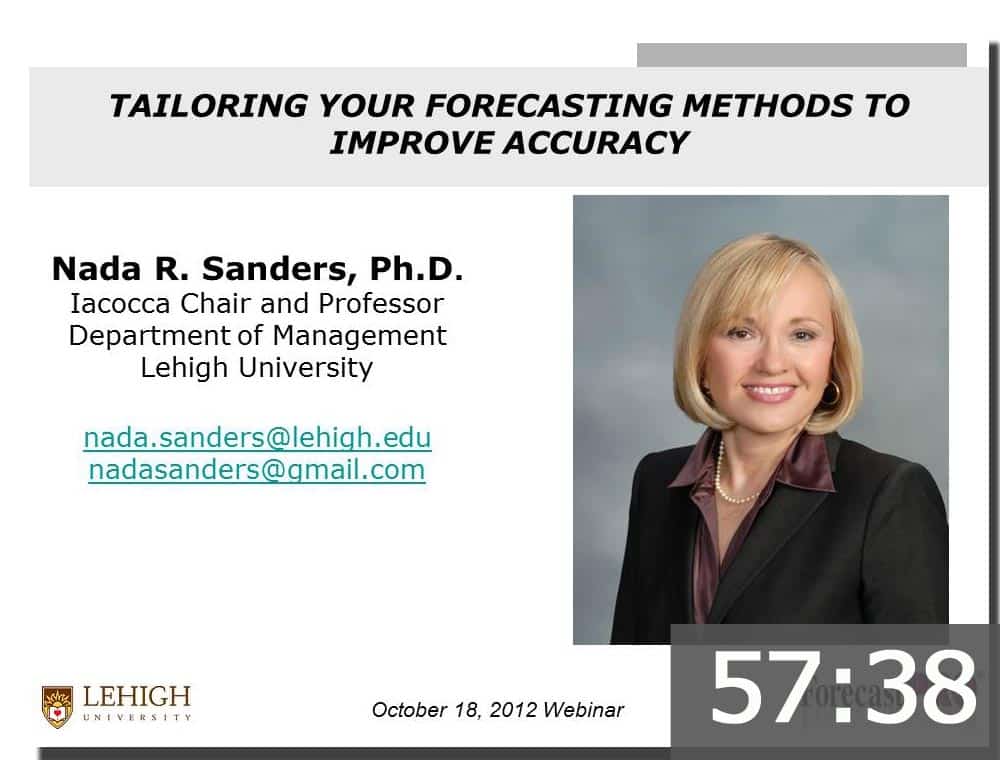Webinars
Do you want to learn about forecasting techniques and best practices that can improve your bottom line, but are pressed to find the time and budget to fit educational events into your schedule? To make it easier for you to stay informed, we invite you to learn from the experts via our free educational Webinars.
Tracking Accuracy: An Essential Step to Improve Your Forecasting Process
If you want to improve your forecasting process then it’s critical to track forecast accuracy. It is only by measuring and monitoring performance that your team can assess how well it is doing, understand what is and isn’t working, and identify where it can improve the process. In this session, Eric Stellwagen, CEO of Business Forecast Systems, Inc. explains how to track forecast accuracy and apply best practices that will make a difference in your own organization.
Forecasting with Machine Learning Demystified
Recent research suggests Machine Learning can improve your forecasting. But although ML offers a powerful set of tools to enhance forecasts, many people find it intimidating. This free educational webinar will demystify the world of forecasting with ML, making it accessible and understandable for both novice and seasoned forecasting professionals.In this free one-hour webinar Sarah Darin will provide an overview of how a Machine Learning algorithm like the one implemented in Forecast Pro works, and discuss the benefits of its application in demand forecasting.
New Product Forecasting: Strategies for Success
Forecasting demand for new products is about as challenging as it gets. With limited or no demand history to guide the way, many traditional forecasting methods simply cannot be used. But don’t despair—there are proven methodologies and strategies that can help you tackle this challenge!
In this one-hour webinar, Eric Stellwagen will explore various methods for effectively forecasting new products. He will also discuss the role of judgement and market research.
AI Driven Forecasting – Fact or Fiction?
There is potential for AI & Machine Learning (ML) to be useful in demand forecasting – but does it actually work in practice, or only in theory? Recent forecasting research suggests that ML can be used to improve your forecasting. In this free one-hour webinar Sarah Darin will provide an overview of how a Machine Learning algorithm like the one implemented in Forecast Pro works, and discuss the benefits of its application in demand forecasting.
Beyond Extrapolation — Using Additional Inputs to Improve Forecast Accuracy
One of the biggest challenges in forecasting is knowing how to create accurate forecasts that consider all the variables that could impact demand. Leveraging additional inputs makes it possible to forecast these variables in order to capture the whole story and improve accuracy. In this free one-hour webinar Eric Stellwagen will explore different types of inputs and explain when they can add value.
How to Forecast Demand in Uncertain Times
Just as the Covid-19 pandemic has disrupted all our lives, it has also significantly impacted virtually all business planning processes. Even years after the onset of the pandemic there is still incredible uncertainty, making business forecasting extremely challenging for demand planners. In this free one-hour webinar, James Berry will discuss common problems organizations are facing and offer some solutions to these problems. He will provide pragmatic insight into how to use various forecasting methods and techniques to create accurate forecasts as we continue to navigate uncertainty from the global pandemic.
The Past and Future of Forecasting – Spyros Makridakis Keynote Presentation
In this one-hour webinar, Spyros provides a brief history of the forecasting field, highlighting the importance of the Makridakis competitions in guiding its progress, and emphasizing the recent achievements of machine learning (ML) methods. In addition, he will discuss the future of forecasting and the challenges and changing role of the professional forecaster when ML methods become widely adopted. This webinar is a recording of Spyros Makridakis’ Keynote Presentation from the September 2022 Forecast Pro User Conference.
Simplifying Inventory Replenishment using Forecast Pro
In this educational one-hour live webinar, Marco Arias Vargas, Founding Partner of Macrologistica and seasoned supply chain educator, will review how to improve resilience and performance in the supply chain based on replenishment models, commonly used replenishment strategies and pitfalls, how to implement replenishment models using Forecast Pro, and keys for tailoring a replenishment strategy to meet the needs of your organization.
Practical Strategies for Forecasting Weekly and Daily Data
In this live one-hour educational webinar, Eric Stellwagen and Sarah Darin discuss strategies for forecasting weekly and daily data, and some issues that may come up when working with this data. Through real-life case studies, you will learn practical approaches for defining the calendar, accommodating Week 53, correcting for the number working days, tracking holidays, forecasting multiple cycles (e.g., day of week and week of year), and converting between different periodicities.
What Is Machine Learning — and Will It Improve My Forecasts?
Machine Learning and AI have emerged as transformational methodologies with a multitude of applications—facial recognition, medical diagnosing and self-driving cars—to name but a few. But can Machine Learning be used to improve your forecasting? Recent forecasting research suggests that it can. In this webinar, Sarah Darin overviews the basics and benefits of automated Extreme Gradient Boosting (XG Boost) an effective and accurate Machine Learning algorithm recently implemented in Forecast Pro.
Staying On Track: How to Prevent Short-Term Forecast Uncertainty From Derailing Your Long-Term Demand Planning
During this webinar, Timm Reiher and Todd Ferguson, two demand management experts from Oliver Wight will discuss strategies for managing uncertainty and explore techniques in demand planning to help you bridge the short and the long term. The webinar will also include a demonstration of how to use the Forecast Pro software to generate both short and longer-term forecasts.
What is Exponential Smoothing and When Should I Use it?
It is no surprise that exponential smoothing models are favored by many corporate forecasters — they are easy to apply, create accurate forecasts, and can be automated. Watch this on-demand webinar to understand the pros and cons of these popular forecasting methods, and learn how to improve your forecasts using exponential smoothing models.
Forecasting Demand in the Face of a Pandemic: What now?
In this webinar, James Berry, Director of Training and Sarah Darin, Senior Consultant, will provide updated guidance on forecasting in the midst of a pandemic, now that we are well immersed in the current crisis and have a better understanding of how businesses have been impacted. Using real data, James and Sarah will provide an overview of the Forecast Pro methods and techniques that can help you generate more accurate forecasts as we enter a “new normal”.
How Bell’s Brewery Improved Supply Planning with Forecast Pro
In this webinar, Blake Violette, Forecast Manager at Bells Brewery, discusses implementing Forecast Pro and how to manage a successful first year. Blake gives an overview of some of the challenges Bell’s Brewery faced in their implementation process, as well as some of the benefits they have reaped from integrating Forecast Pro into their forecasting and S&OP processes
Forecasting Demand in the Face of a Pandemic
In this Webinar Eric Stellwagen, CEO, and Sarah Darin, Senior Consultant, provide pragmatic insight into how to create your forecasts throughout all phases of a pandemic—including the current initial stage, the uncertain months ahead and the subsequent “new normal” that will emerge. Drawing upon their extensive expertise in forecasting approaches that have been successfully used during other business disruptions, they profile several business categories, review the methods that are best suited to each group and demonstrate these approaches in Forecast Pro TRAC using real-world examples.
The Role of Judgment in a Successful Forecasting Process
Both statistical forecasting methods and business judgment can be instrumental in creating accurate forecasts, but when and how to incorporate judgment into your forecasting process is a challenge. This webinar will give you the tools for assessing how integrating judgment can improve your own forecasting process.
How to Integrate Replenishment Models with your Forecasting Process
Optimizing inventory levels has always been a challenge, and in today’s environment—with highly-informed customers, SKU proliferation and omni-channel order processes—it is even harder to reach that goal. By building replenishment models that complement your business forecasting processes, your company can manage inventory more effectively to keep it flowing efficiently through the Supply Chain.
Smart Strategies for Designing, Implementing and Improving an Effective Demand Forecasting Process
For many companies, developing a successful forecasting process can seem daunting considering the challenges that may arise at each step along the way. In this educational one-hour Webinar, James Berry, Senior Consultant at Business Forecast Systems, Inc. reviews a framework to help your forecasting team create a roadmap for designing, implementing and improving upon your forecasting process.
Four Basic Steps for Creating an Effective Demand Forecasting Process
No matter how sophisticated the forecasting process is in your organization, four basic steps are required for it to be effective. In this session, Eric Stellwagen, CEO of Business Forecast Systems, Inc., reviews each of these important steps—generating baseline forecasts, adding judgment, tracking accuracy and improving the process—focusing on best practices and the pitfalls to avoid.
Effective Strategies for Forecasting a Product Hierarchy
Many organizations require a consistent set of forecasts across product and/or geographical hierarchies, causing forecasters to grapple with a host of daunting issues. In this session, Eric Stellwagen, CEO, and Sarah Darin, Senior Consultant, explains the ins and outs of forecasting a product hierarchy, addressing issues such as whether your organization strive for “one-number” forecasts across departments and how to define the hierarchy to facilitate accurate forecasting. Using real-world examples, they compare and contrast different strategies for forecasting a product hierarchy, emphasizing best practices.
Effective Strategies for Forecasting
New Products
Forecasting new products is a challenge. When little or no historical data are available, the trusted forecasting methods that work well for existing products often produce inaccurate results for new products. In this Webinar, Eric Stellwagen, CEO, and Sarah Darin, Senior Consultant at Business Forecast Systems, Inc., survey various pragmatic approaches for forecasting new products more accurately.
How to Boost Your Forecast Accuracy by Modeling the Impact of Promotions and Other Events
Does your forecast accuracy suffer as a result of product promotions, stockouts, large one-time orders and/or other irregular events? In this educational one-hour session, learn how and when to use event models, how event models work and how to build customized event variables that suit the needs of your business.
The Ins and Outs of Using Dynamic Regression Models for Forecasting
Do you want to build causal factors such as prices, promotions and economic indicators into your forecasts, but fear that building regression models is too complex and difficult? This session demystifies dynamic regression modeling, demonstrating how these models can provide insight into your data and revealing why they often yield more accurate results than alternative forecasting methods.
Advancing from S&OP to True Business Integration
In this session, Professor Mark Moon provides useful tools for auditing and improving your organization’s planning capabilities including a framework for assessing the extent to which your S&OP process achieves actual Business Integration. He explains what true Business Integration is, and examines how organizational structure, processes, and culture contribute to achieving this elusive goal.
Forecasting Weekly and Daily Data: Practical Strategies for Better Results
Creating accurate weekly or daily forecasts can be challenging. In this session, Eric Stellwagen, CEO of Business Forecast Systems, Inc. reviews a number of practical approaches — including some that tend to be overlooked — that your team can adopt to improve your weekly or daily forecasts.
The Ins and Outs of Exponential Smoothing
It’s no surprise that exponential smoothing is the method of choice for many corporate forecasters—the technique creates accurate forecasts, is easy to apply, and can be automated. In this educational one-hour live Webinar, Eric Stellwagen, Vice President of Business Forecast Systems reviews the ins and outs of this popular forecasting method.
Embracing Forecast Uncertainty: Confidence Limits, Safety Stock & Order Quantities
Most forecasters realize that it is extremely unlikely that their forecasts will be 100% accurate but still depend upon them to guide the business. Understanding the uncertainty around a forecast is essential for using it in a way that improves the decision making process. In this educational one-hour live Webinar, James Berry, Director of Training at Business Forecast Systems, explains pragmatic approaches for dealing with forecast uncertainty.
How to Leverage Forecasting and a Demand Control Process to Improve Customer Service
It can become a major distraction to your organization when actual demand varies significantly from what is planned, typically leading to time-consuming exercises to “close the gap.” In this Webinar, Timm Reiher and Todd Ferguson, Principals at Oliver Wight, explain how to implement a consistent demand control process, including incorporating statistical forecasts with inputs from multiple sources to create a demand plan.
Addressing the Challenges of New Product Forecasting
In this educational one-hour Webinar, Dr. Kenneth Kahn, Professor of Marketing and Director of the da Vinci Center at Virginia Commonwealth University reviews a variety of pragmatic approaches that you can use to forecast new products more accurately.
Understanding Your Data: The Key to Better Forecasting
Business forecasters rely heavily on time series methods which typically capture structure in the data — such as sales levels, trends, seasonal patterns, business cycles and responses to promotions — which is critical for creating the forecast. Eric Stellwagen, Vice President of Business Forecast Systems, teaches you how to recognize the different components in your demand history and explains which elements you can — and cannot — forecast effectively.
Integrating Statistical Forecasts with Other Input to Create a Demand Plan for S&OP
In this educational, one-hour Webinar, learn from acclaimed expert Colleen “Coco” Crum, Principal at Oliver Wight, who will show you how to obtain different views of demand and integrate them to create a proposed demand plan.
How to Effectively Combine Judgment with Statistical Forecasts
In this one-hour Webinar Paul Goodwin, Professor Emeritus, University of Bath, will present a series of practical recommendations to ensure that you are making forecast adjustments for the right reasons and to show you how to avoid pitfalls.
What Now? How to Proceed When Automatic Forecasting Doesn’t Work
Does your organization rely heavily on automated extrapolation-based forecasting algorithms despite being dissatisfied with some of the results? Watch this educational one-hour Webinar to learn practical ways to improve your forecasts when the “one size fits all” approach of these automatic methods falls short.
Identifying Problems in Your Data and Forecasts
Although most business forecasters would welcome the chance to review each item every forecasting cycle, with limited resources this is simply not possible. Eric Stellwagen, Vice President of Business Forecast Systems, explains pragmatic approaches for identifying problem area quickly and systematically—both in the history and forecasts.
A Roadmap for Improving Forecasting in Demand Planning and S&OP Processes
Forecasting is a critical part of Demand Planning and S&OP processes. Almost all organizations can improve their forecasting—often dramatically—by assessing current processes and implementing changes where they add value. In this Webinar, James Berry, Senior Consultant at Business Forecast Systems, reviews methods, best practices and processes that you can implement to improve forecasting in your organization.
How to get Good Forecasts from Bad Data
Business forecasters are expected to create accurate forecasts regardless of the quality of the inputs and, unfortunately, most have no choice but to work with less-than-perfect data. In this educational session, Ellen Bonnell, CEO of Trends Savants, shares seven guiding principles for getting good forecasts from bad data.
The 7 Habits of Highly Effective S&OP
S&OP is a process designed to bring together a variety of functions in an organization. While many companies recognize the potential benefits of S&OP, they often struggle to implement the process with any level of effectiveness. Dr. Mark Moon, Director of the Forecasting & Demand Management Forum at the University of Tennessee, explores ways to make S&OP implementations more effective–the key to success.
